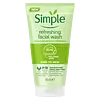What's inside
What's inside
 Key Ingredients
Key Ingredients

No key ingredients
 Benefits
Benefits

 Concerns
Concerns

 Ingredients Side-by-side
Ingredients Side-by-side

Water
Skin ConditioningPropylene Glycol
HumectantSodium Laureth Sulfate
CleansingCocamidopropyl Betaine
CleansingJojoba Esters
EmollientSodium Lauroamphoacetate
CleansingDisodium Lauroamphodiacetate
CleansingLauryl Methyl Gluceth-10 Hydroxypropyldimonium Chloride
Sodium Carbomer
Emulsion StabilisingGlycol Distearate
EmollientPEG-120 Methyl Glucose Dioleate
EmulsifyingLaureth-4
EmulsifyingLactic Acid
BufferingParfum
MaskingTetrasodium EDTA
Polysorbate 20
EmulsifyingMethylchloroisothiazolinone
PreservativeMethylisothiazolinone
PreservativeWater, Propylene Glycol, Sodium Laureth Sulfate, Cocamidopropyl Betaine, Jojoba Esters, Sodium Lauroamphoacetate, Disodium Lauroamphodiacetate, Lauryl Methyl Gluceth-10 Hydroxypropyldimonium Chloride, Sodium Carbomer, Glycol Distearate, PEG-120 Methyl Glucose Dioleate, Laureth-4, Lactic Acid, Parfum, Tetrasodium EDTA, Polysorbate 20, Methylchloroisothiazolinone, Methylisothiazolinone
 Reviews
Reviews

Ingredients Explained
These ingredients are found in both products.
Ingredients higher up in an ingredient list are typically present in a larger amount.
Cocamidopropyl Betaine is a fatty acid created by mixing similar compounds in coconut oil and dimethylaminopropylamine, a compound with two amino groups.
This ingredient is a surfactant and cleanser. It helps gather the dirt, pollutants, and other impurities in your skin to be washed away. It also helps thicken a product and make the texture more creamy.
Being created from coconut oil means Cocamidopropyl Betaine is hydrating for the skin.
While Cocamidopropyl Betaine was believed to be an allergen, a study from 2012 disproved this. It found two compounds in unpure Cocamidopropyl Betaine to be the irritants: aminoamide and 3-dimethylaminopropylamine. High-grade and pure Cocamidopropyl Betaine did not induce allergic reactions during this study.
Learn more about Cocamidopropyl BetainePropylene Glycol is an odorless, colorless liquid. As a humectant, it helps skin retain moisture. It also aids in delivering active ingredients.
Another role of this ingredient is preventing a product from melting or freezing. Propylene glycol also adds antimicrobrial properties to a product, elongating product lifespan.
This ingredient is considered an organic alcohol and commonly added into both cosmetics and foods.
Those with sensitive skin or conditions may develop a rash when using this ingredient.
Learn more about Propylene GlycolWater. It's the most common cosmetic ingredient of all. You'll usually see it at the top of ingredient lists, meaning that it makes up the largest part of the product.
So why is it so popular? Water most often acts as a solvent - this means that it helps dissolve other ingredients into the formulation.
You'll also recognize water as that liquid we all need to stay alive. If you see this, drink a glass of water. Stay hydrated!
Learn more about Water